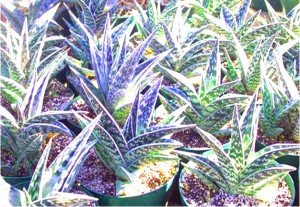There are over 500 different species of aloe, ranging dramatically in size and shape. Some species of Aloes are miniature – only reaching a few inches tall, while others form massive, singular rosettes or ground covering colonies, numbering in the hundreds. They are marked by their large rosette of think, fleshy sword-like leaves and clusters of tubular yellow, orange, or pink flowers. The nectar from Aloes are a favorite among hummingbirds and butterflies!
 Aloes also range in color from gray to pale blue, bright green, and even striped patterns.
Aloes also range in color from gray to pale blue, bright green, and even striped patterns.They make great indoor or outdoor plants, as long as frosts are not in the forecast. Because Aloe plants are native to warm, dry climates, they do not do well in cold temperatures. In general, they like full sun or light shade. The soil provided should drain well, and once established, Aloes are quite drought tolerant. In the maturing process, regular watering should be given. After that, Aloes require very little water, and be sure to let soil dry completely between waterings.
Because Aloes are succulent plants, they store a large amount of water within its leaves and root system, so water should be given minimally during the winter months. Aloes are low maintenance landscaping plants but do benefit from annual fertilizing. They are not particularly fast growing, and will rarely need re-potting. However, they can be propagated during re-potting by carefully dividing the root ball. Some Aloes will assist the process by producing off-sets that can be potted individually. It has been reported that Aloes are so hardy and forgiving that even after being uprooted and tossed aside for some time, they are easily regenerated back to thriving in a very short time. They also have a long lifespan, up to 25 years!
Aloe’s healing abilities have been traced back to ancient Egypt, Greece, and Rome. The Aloe Vera especially is known for its amazing medicinal properties. It can be used internally and externally for a variety of uses – from digestive health, abrasions, sunburns, allergies, infections and even chronic fatigue and an added ingredient in many soaps and cosmetics. After breaking off part of its fleshy stem, you can see the gel like liquid the plant produces. The cut segment will quickly heal over where it was sliced and retain its plumpness to stay green for several days. In a refrigerator, a cut segment will keep for two or three weeks. Both the clear inner pulp and the resinous yellow “Aloin” can be used to relieve skin issues, even poison ivy!
Aloe Vera is reported to have antiseptic properties and a great item to have in any first aid kit! The juice is also used internally to help relieve digestive discomforts. The yellow sap of the aloe plant has also been used as a laxative ingredient. Not only do Aloe Vera provide a wide range of helpful healing uses it is a wonderful addition to your yard or Xeriscape. All Aloes are great options for desert landscaping. Of the 500 species, very few of them are commonly found in cultivation. However, Envirogreen has plenty to choose from, and can assist you in choosing the best ones for you!
 Aloes are a perfect addition to any landscape design, and can add dynamic shapes and interesting patterns.
Aloes are a perfect addition to any landscape design, and can add dynamic shapes and interesting patterns.For example, the variegated Tiger Aloe forms bunches of low rosettes with green bands on wide yellow and green leaves, making them great for a ground cover that needs very little water! Consult the experts at Envirogreen for more great ideas for showcasing your Aloe!